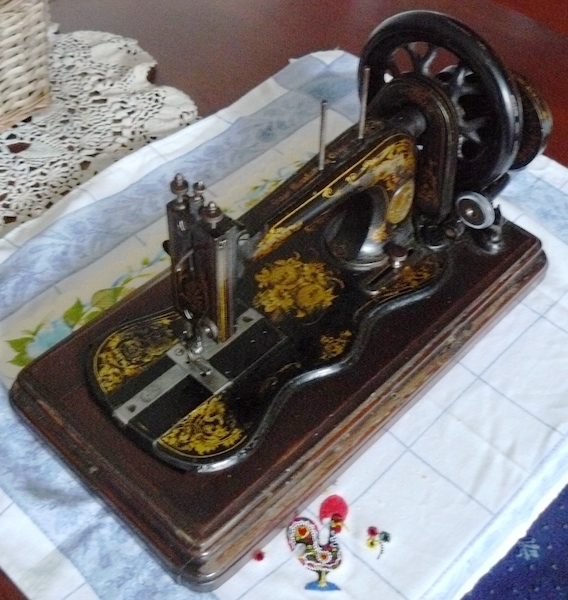Eva Athena Sewing Machine Manual

A Beeston lady told this story …
The year is 1886, in a small town called Wolverton near Northampton lived a thirteen year old girl, Miss Edith Rock, and Edith had just completed her limited education.
However, she had shown an interest in all manner of needlework, and was very adept at all she attempted. to encourage their daughter's independence, her parents bought her a 'Singer Sewing Machine'. The model was known as a 'Table Top', it was dual-working, the operator could work by hand or have it hands free and work by a treadle from underneath.
During the late 1880s and early 1890s the machine was in constant use, consequently with progress, Edith rented two small rooms, the front room as a Haberdashers (Drapers Shop) and the rear room where the machine was installed for her work.
In 1897, Edith now aged twenty-four had met and was marrying a certain Edwin Mackerness (Ted). He helped Edith acquire much larger premises, now owned not rented, in Church Street, Wolverton. Another 'Singer' was purchased, and a young lady was employed to help with the sewing and serve in the shop, though only Edith herself would use the 'Table Top'. The machine always in use, the dressmaking progressed, and the Drapery Shop continued to flourish, a printed card for this business still survives with the machine.
In June 1901 and Edith had a baby boy, the clothes for him being turned out by the machine. Six weeks later her mother-in-law produced a baby girl. Bearing the same surname, and being christened 'Edith' there were now two Edith Mackerness' to feature in the life of the machine.
As the years passed the second Edith was taught to use the machine, the only person allowed, apart from the first Edith.
Through the First World War our machine is churning out military undergarments. On into the Roaring 20s and the machine, now back to producing lightweight civilian clothing, mostly it was undergarments, with the occasional 'Made-to-Order' dress for 'Better Off' customers.
By 1938 the first Edith Mackerness had reached her mid-sixties and with failing eyesight and arthritic hands decided to retire. The machine was passed on to the second Edith, now Edith Rollings, married with a daughter born in 1933, and living close to Wolverton at Stony Stratford.
So the machine now has a change of venue, change of ownership, and less work, it being mainly for domestic use only for family and friends. Fabric was hard to get hold of during the Second World War, but Edith managed to find some 'Parachute Silk'. She used some it to make a dress for her seven year old daughter. The white fabric was brightened up with coloured binding at the neck and sleeves, with a matching coloured sash; this I remember well for I am that seven year old daughter, now aged eighty-six.
I moved to Leeds (Beeston) in 1980 and in 1983 the 'Singer' came north after my mother, the second Edith, passed away aged eighty-two.
Following in family footsteps I had been taught to use the machine in my teenage years, it had been many years since I had seen it let alone use it, and the first thing to gen-up on was how to thread it. Leeds being a city with connections to the clothing trade most of my friends had a sewing machine, but more recent models, with a bobbin, mine had a shuttle and there lie the difference. The shuttle was about 1¼ inch in length, pointed at one end, looking just like a toy open rowing boat. To accompany the shuttle there are several small spindles about an inch long, any one of which could be clipped into the shuttle.
The shuttle had a row of holes on one side with a bar below them, and when threading, the thread needed to go back and forth from hole to hole, and then under the bar, there was a set sequence through the holes and if you got it wrong nothing worked. Fortunately, the second Edith had written out instructions on a sheet of paper (now brown with age) and once these were adhered to the 'Singer' was back in action; not making garments any more but altering and shortening, skirts, trousers, etc. and on one occasion making curtains and sewing on 'Rufflette Tape'.
All went well until the late 1980s, when I went to purchase more needles, only to be told they were shortly becoming obsolete. The salesman had just seven left in stock, so I took all seven (of which there are still six left). Then in the early 1990s it was realised that the machine, though sewing was not locking and a pull on the thread meant that all that had just been stitched immediately came undone.
A resident in Beeston, qualified and renowned for sewing machine repairs was called in. He could find nothing wrong with the mechanism, when he noticed I had threaded the machine with a fine 'polyester thread'! Apparently it was all that I had been able to purchase, but the 'Singer' had been designed to work only with Sylko Grade 40 and the new polyester threads were much too fine. Unfortunately, Sylko was no longer in production, the Company having gone out of existence.
So at last, after 100 years and probably a lot more, the machine has gone into retirement, not dead, as its still workable, with the right equipment, but forced into sleeping.
This post was written by Ken Burton
We encourage anyone living or working in South Leeds to use this website to tell their news. You can either use the Create an article for South Leeds Life page, or email us at: info@southleedslife.com
Eva Athena Sewing Machine Manual
Source: https://southleedslife.com/the-story-of-a-family-and-a-singer-sewing-machine-number-2261060-490260/
Comments
Post a Comment